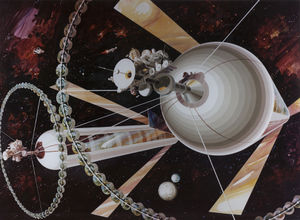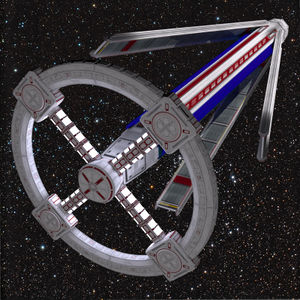O'Neill cylinders
| This page is written or contains material written in the metafictional (or OOC) voice. This material may contain spoilers, Easter Eggs, or other data not generally known in the world of Fenspace. The reader is duly warned. -The Mgt. |
The Island Three[1] space station design, also known as the O'Neill Cylinder, was proposed by Gerard K. O'Neill in The High Frontier: Human Colonies in Space[2] as part of a plan to colonize space.
These possible stations would be made up of two counter-rotating connected cylinders, each 8 km in diameter and 32 km long[3]. These would rotate to provide artificial gravity via centrifugal force on their inner surfaces.
Each cylinder would have six equal-area "stripes," alternating windows and living areas, running the length of the cylinder. The station would have an additional outer agriculture ring, 32 km in diameter, rotating at a different speed. Manufacturing would take place in the middle of the station, to allow for reduced "gravity" for certain manufacturing processes.
O'Neill proposed that these stations would be built using materials from the Moon.
O'Neill Cylinders in Fenspace

As of 2015 there are no full sized O'Neill cylinders in Fenspace. Compared to a Bernal sphere or even a ring station design such as Stellvia, an O'Neill cylinder is a very complicated habitat to construct with at least three large rotating parts. One would also provide a larger amount of habitable space (approx 270 km²) than most of the smaller factions need and most of the larger factions have other plans.
However, given the nature of Fenspace an O'Neill cylinder will eventually get built.
Notes
- Jump up ↑ For information on the Island One and Island Two station designs, see the Bernal sphere entry.
- Jump up ↑ O'Neill, Gerard K. (1977). The High Frontier: Human Colonies in Space. New York: William Morrow & Company. ISBN 0-688-03133-1.
- Jump up ↑ 5 miles long and 20 miles in diameter, for the metric-challenged.
